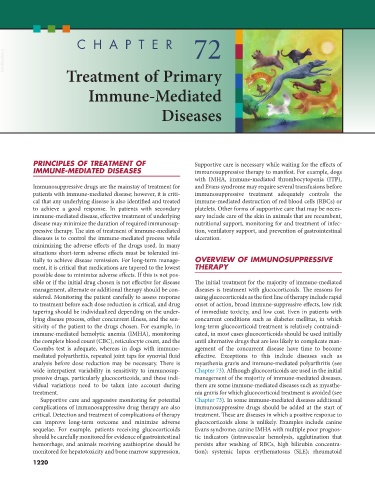Page 1248 - Small Animal Internal Medicine, 6th Edition
P. 1248
1220 PART XI Immune-Mediated Disorders
CHAPTER 72
VetBooks.ir
Treatment of Primary
Immune-Mediated
Diseases
PRINCIPLES OF TREATMENT OF Supportive care is necessary while waiting for the effects of
IMMUNE-MEDIATED DISEASES immunosuppressive therapy to manifest. For example, dogs
with IMHA, immune-mediated thrombocytopenia (ITP),
Immunosuppressive drugs are the mainstay of treatment for and Evans syndrome may require several transfusions before
patients with immune-mediated disease; however, it is criti- immunosuppressive treatment adequately controls the
cal that any underlying disease is also identified and treated immune-mediated destruction of red blood cells (RBCs) or
to achieve a good response. In patients with secondary platelets. Other forms of supportive care that may be neces-
immune-mediated disease, effective treatment of underlying sary include care of the skin in animals that are recumbent,
disease may minimize the duration of required immunosup- nutritional support, monitoring for and treatment of infec-
pressive therapy. The aim of treatment of immune-mediated tion, ventilatory support, and prevention of gastrointestinal
diseases is to control the immune-mediated process while ulceration.
minimizing the adverse effects of the drugs used. In many
situations short-term adverse effects must be tolerated ini-
tially to achieve disease remission. For long-term manage- OVERVIEW OF IMMUNOSUPPRESSIVE
ment, it is critical that medications are tapered to the lowest THERAPY
possible dose to minimize adverse effects. If this is not pos-
sible or if the initial drug chosen is not effective for disease The initial treatment for the majority of immune-mediated
management, alternate or additional therapy should be con- diseases is treatment with glucocorticoids. The reasons for
sidered. Monitoring the patient carefully to assess response using glucocorticoids as the first line of therapy include rapid
to treatment before each dose reduction is critical, and drug onset of action, broad immune-suppressive effects, low risk
tapering should be individualized depending on the under- of immediate toxicity, and low cost. Even in patients with
lying disease process, other concurrent illness, and the sen- concurrent conditions such as diabetes mellitus, in which
sitivity of the patient to the drugs chosen. For example, in long-term glucocorticoid treatment is relatively contraindi-
immune-mediated hemolytic anemia (IMHA), monitoring cated, in most cases glucocorticoids should be used initially
the complete blood count (CBC), reticulocyte count, and the until alternative drugs that are less likely to complicate man-
Coombs test is adequate, whereas in dogs with immune- agement of the concurrent disease have time to become
mediated polyarthritis, repeated joint taps for synovial fluid effective. Exceptions to this include diseases such as
analysis before dose reduction may be necessary. There is myasthenia gravis and immune-mediated polyarthritis (see
wide interpatient variability in sensitivity to immunosup- Chapter 73). Although glucocorticoids are used in the initial
pressive drugs, particularly glucocorticoids, and these indi- management of the majority of immune-mediated diseases,
vidual variations need to be taken into account during there are some immune-mediated diseases such as myasthe-
treatment. nia gravis for which glucocorticoid treatment is avoided (see
Supportive care and aggressive monitoring for potential Chapter 73). In some immune-mediated diseases additional
complications of immunosuppressive drug therapy are also immunosuppressive drugs should be added at the start of
critical. Detection and treatment of complications of therapy treatment. These are diseases in which a positive response to
can improve long-term outcome and minimize adverse glucocorticoids alone is unlikely. Examples include canine
sequelae. For example, patients receiving glucocorticoids Evans syndrome; canine IMHA with multiple poor prognos-
should be carefully monitored for evidence of gastrointestinal tic indicators (intravascular hemolysis, agglutination that
hemorrhage, and animals receiving azathioprine should be persists after washing of RBCs, high bilirubin concentra-
monitored for hepatotoxicity and bone marrow suppression. tion); systemic lupus erythematosus (SLE); rheumatoid
1220

